Maintaining fish and other animals in an aquarium requires much effort in cleaning, feeding, setting filters, and more. Among those, adding Calcium is vital for the health of fish and coral in your aquarium. If you’re looking to add a calcium supplement to your aquarium, there are a few things you need to know.
In this blog post, National Park Aquarium will discuss what Calcium is, why you need it in your tank, and how to add it safely. We’ll also look at some popular calcium supplements on the market today.
So read on for all you need to know about keeping your aquarium healthy with supplemental Calcium!
What is Calcium for Aquarium?
Calcium is a mineral that is found in the environment. It’s one of the most abundant minerals on Earth, and it’s an important part of many rocks and minerals.
Calcium is also found in the water we drink and our food. Our bodies need Calcium for numerous functions, including bone and teeth formation, blood clotting, and muscle contraction.
While we need Calcium for our own health, it’s also essential for the health of our aquariums. Fish and coral use Calcium to build their bones and skeletons.
In fact, Calcium makes up about 70% of a fish’s skeleton! And Coral also needs Calcium to build its hard exoskeleton.
The Crucial Role of Calcium in Aquariums

If you have an aquarium with fish or coral, it’s important to maintain proper calcium levels. Without enough Calcium, fish and coral can become weak and sick. In fact, a lack of Calcium can even cause death.
In nature, stone erosions turn into calcium deposits, making the lake and river water rich with nutrients for fish, plants, and other lives’ growth. Therefore, in an aquarium environment, the owner should add this mineral through various means for the health and development of both fish and coral.
How Do I Add Calcium to Aquarium
There are a few different ways to add Calcium to your aquarium. The method you choose will depend on the size and type of your aquarium and your budget. Here are some popular methods for adding Calcium to your tank:
1. Adding Coral
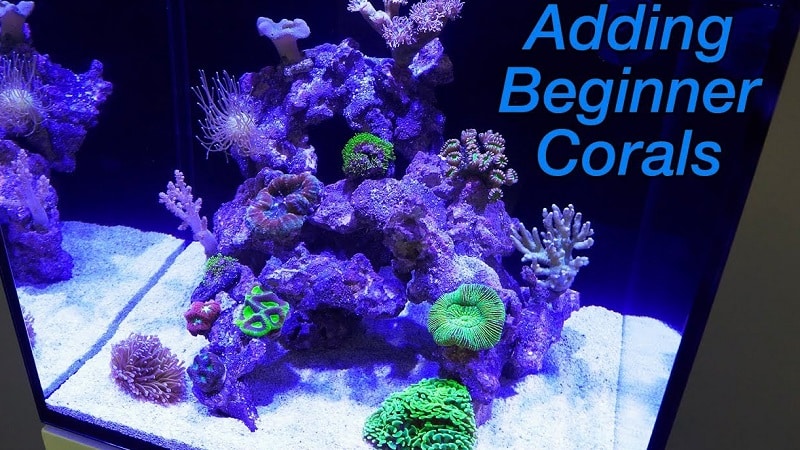
Instead of using the usual corals for decoration, you should use a mix of crushed coral and gravel for added Calcium.
- You can place the crushed coral in a mesh bag and suspend them in the tank.
- You can also put a small mesh bag of coral inside the filter.
As the water flows over the coral, Calcium will be released into the water.
2. Use Live Rock to Add Calcium
Live rock is a great way to add Calcium to your aquarium, as it contains high mineral levels. Live rock can be collected from the wild or purchased from a pet store.
If you collect a live rock from the wild, rinse it thoroughly with fresh water before adding it to your aquarium.
3. Adding a Cuttlebone
A cuttlebone can add Calcium to your aquarium and provide other vital minerals and trace elements. A cuttlebone is the internal shell of a cuttlefish and can be purchased at most pet stores.
- You can boil the cuttlebone to make it sink in your aquarium. Then, it will slowly dissolve, releasing Calcium and other minerals into the water.
- Another way is to place the cuttlebone inside the filter.
- You can also purchase unique holders for cuttlebones that attach to the side of your aquarium.
4. Adding Calcium to the diet
Adding a Calcium supplement to your fish food is a convenient method, suitable for smaller aquariums. There are many different types of fish food on the market that contain Calcium, including:
- Brine shrimp
- Krill
- Certain types of algae
5. Adding eggshells to Aquarium
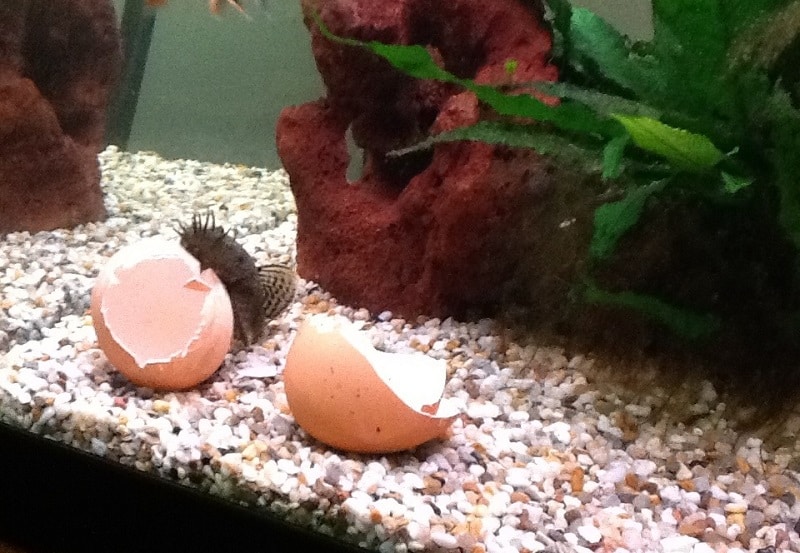
Many might not know that boiled eggshells can be a decent source of Calcium for a small fish tank when the owners are short on time to shop for minerals.
- Make sure to remove all the egg membranes, then boil the shells.
- Place those shells out of the fish’s reach to prevent it from making a mess
- Take the old eggshells after two weeks or so to avoid a bad smell
6. Setting up a Calcium reactor
A calcium reactor is one of the most effective ways to add Calcium to your aquarium on a regular basis. A calcium reactor works by dissolving calcium carbonate media in water to create a highly concentrated calcium solution. This solution is then pumped into your aquarium, where it Raises the overall calcium levels in the water.
A Calcium reactor is an excellent option for larger aquariums, but it can be expensive.
You can set one up following the instructions with the required equipment, including Calcium carbonate, Carbon dioxide, a solenoid valve, a pump, and additional tools.
Just make sure to set a stable pH level ranging from 6.3 to 6.8, depending on the type of fish you have.
7. Using Commercial Products to add Calcium
There are many commercial products available for adding Calcium to your aquarium. These products are typically powders or liquids and can be added directly to the water.
Be sure to follow the instructions on the packaging carefully, as too much Calcium can be harmful to your fish and other aquatic creatures.
8. Making Your Own DIY Solution
You can also make your DIY calcium solution using food-grade limestone or oyster shell powder.
- Simply mix the powder with distilled water in a ratio of 1:1 and let it sit for 24 hours.
- After 24 hours, strain the solution through a coffee filter or cheesecloth and add it to your aquarium.
- Be sure to use this solution within two weeks, as it will lose its potency.
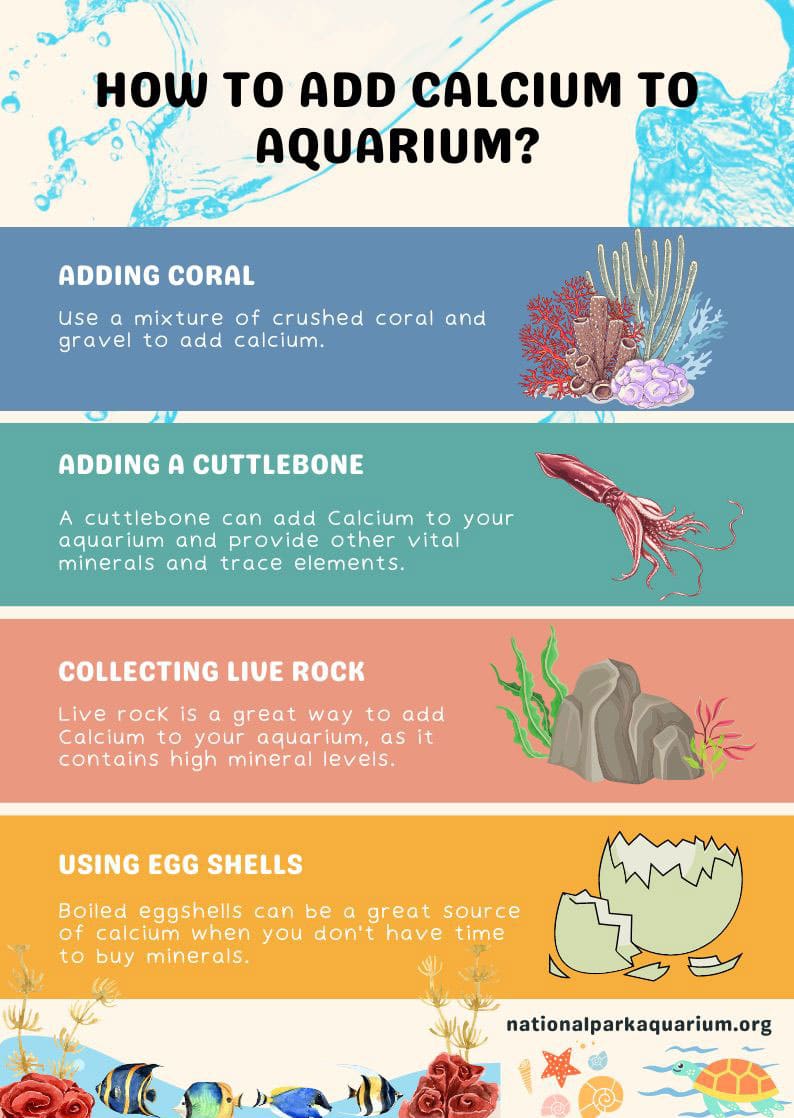
How to Test Calcium in a Freshwater Aquarium
Ensuring the right calcium levels in your freshwater aquarium is essential for the well-being of your fish and other aquatic creatures.
Calcium plays a vital role in the growth and health of fish and coral, making it crucial to monitor and maintain appropriate levels.
Here’s a step-by-step guide on how to test calcium levels in your freshwater aquarium:
- Calcium Test Kits: The market offers various calcium test kits designed specifically for freshwater aquariums. These kits come with detailed instructions, making the testing process straightforward.
- Follow the instructions carefully to get accurate and reliable results.
- Collecting Water Samples: Before testing, collect water samples from different areas of your aquarium. This practice ensures a comprehensive representation of the overall calcium levels.
- Be sure to handle the samples with care.
- Testing Procedure: Calcium test kits usually employ colorimetric testing methods. By adding specific reagents to the water sample, the color changes based on the calcium concentration.
- Compare the resulting color to the provided color chart in the test kit to determine the calcium levels accurately.
- Frequency of Testing: Regular testing is essential, especially if your aquarium houses corals or other calcium-dependent organisms.
- Testing once a week is generally recommended, but you can adjust the frequency based on your aquarium’s specific needs.
- Recording Results: Maintaining a record of the calcium test results over time will allow you to track any fluctuations or trends in the calcium levels.
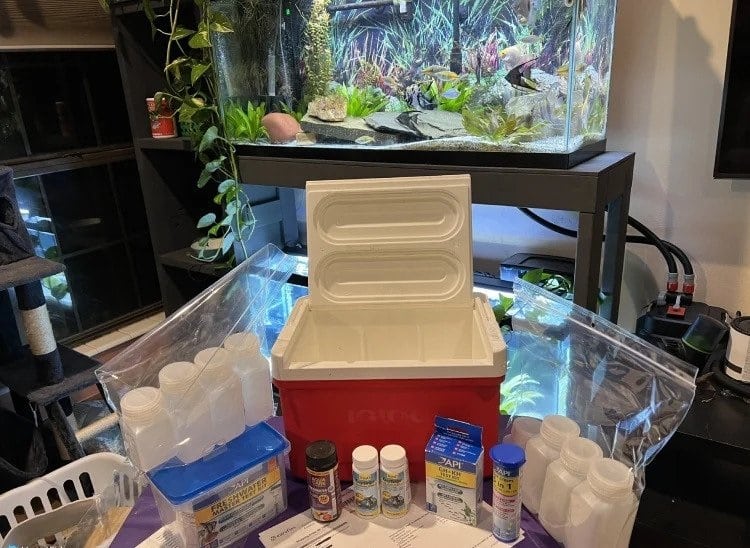
This documentation is crucial for identifying issues and making necessary a djustments to maintain stable calcium levels.
Tips for Maintaining Proper Calcium Levels
Now that you know how to add Calcium to your aquarium, let’s take a look at some tips for maintaining proper calcium levels:
Test your water regularly to make sure the calcium levels are where they should be. There are many different types of test kits on the market, so be sure to choose one that’s designed for use in saltwater or freshwater aquariums.
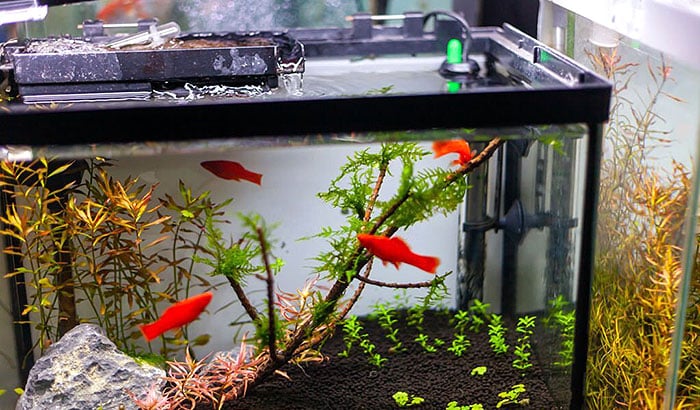
Regularly clean your aquarium. Aquariums can become depleted of Calcium over time. Cleaning on a set schedule will help remove any debris build-up that could affect the calcium levels in your tank.
Changing your water regularly helps maintain proper calcium levels. Be sure to use proper cleaning tools and use a high-quality salt mix when adding new water to your tank.
Avoid using tap water. Tap water can contain chemicals that can deplete the Calcium in your aquarium. If you must use tap water, let it sit for 24 hours before adding it to your tank. This will give the chemicals time to dissipate.
By following these tips, you can help ensure that your aquarium has the proper calcium levels it needs to maintain the health of your fish and coral.
Conclusion
Calcium is a vital mineral for both freshwater and saltwater aquariums. Without it, your fish and other aquatic creatures will be less healthy and may not survive.
The above methods provide safe and effective ways to add calcium to your aquarium. You can choose from a variety of options, such as adding cuttlebones, calcium blocks, calcium hydroxide (kalkwasser), liquid calcium chloride, and wonder shells. Additionally, you can improve calcium levels in your aquarium by using crushed oyster and eggshells.
When adding Calcium to your aquarium, no matter which method you choose, add Calcium to your aquarium slowly and in small amounts to avoid any sudden changes in water chemistry that could harm your fish and other aquatic creatures.
National Park Aquarium hope this article has helped you how to add calcium to aquarium and learn more about the importance of Calcium in an aquarium and how to add it effectively.




